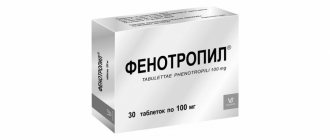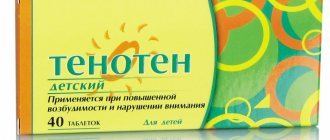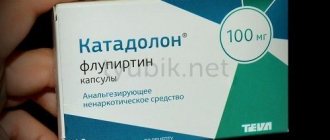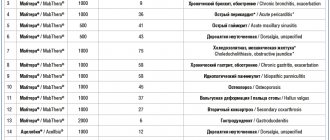Compound
The active substance of Sonapax, whose international name (INN) is thioridazine, is thioridazine hydrochloride , which contains 10 mg or 25 mg per tablet.
The excipients are: lactose monohydrate, talc, colloidal silicon dioxide, gelatin, corn starch, stearic acid.
The shell contains acacia gum, sucrose, talc, and dye.
Pharmacodynamics and pharmacokinetics
The active substance has a central and peripheral effect on the nervous system. The substance can suppress certain functions of the brain stem, as well as have an antihistamine and quinolytic effect . It does not suppress motor activity, has no antiemetic effect, and estrapyramidal disorders less frequently than other antipsychotics.
In addition, thioridazine has a weak antidepressant, anti-autism and antipsychotic effect.
Absorbed completely from the intestines. Reaches maximum concentration after administration after 2-4 hours. About 35% of the drug is excreted by the kidneys, the rest is excreted through the intestines (both in pure form and in the form of metabolites). through the hematoplacental barrier into breast milk.
Mechanism of action of the drug
Sonapax is used as a tranquilizing, antidepressant and antipsychotic drug. Penetrating into the body, thioridazine affects the functions of the central nervous system and normalizes vegetative manifestations. The drug has a moderate antihistamine and slight antipsychotic effect, improves memory and mental performance, and does not change the speed of motor reactions. Unlike other antipsychotics, it works more gently and does not provoke estrapyramidal disorders. Sonapax does not have an antiemetic effect, this is important to remember when prescribing it.
The tablets are completely absorbed from the gastrointestinal tract within 1 hour. The maximum concentration in the blood is reached 2–3 hours after administration. The drug is metabolized in the liver, partially excreted by the kidneys, mainly through the intestines.
Indications for use of Sonapax
The drug is prescribed for the following diseases:
- schizophrenia;
- psychomotor agitation;
- withdrawal syndrome;
- psychoses;
- Huntington's disease;
- schizoaffective disorders;
- teak;
- psychosomatic disorders;
- aggressiveness, inability to concentrate for long periods of time;
- neuroses , which are accompanied by sleep disorders, anxiety, obsessive states, psycho-emotional stress, depressive disorders, fear;
- skin diseases that are accompanied by severe itching.
For children, indications for the use of Sonapax are behavioral disorders accompanied by increased psychomotor activity.
Indications
- schizophrenia (as a second-line drug in patients for whom other drugs are contraindicated or there is no therapeutic effect when taking other drugs);
- psychotic disorders accompanied by hyperreactivity and agitation;
- severe behavioral disorders associated with aggressiveness, inability to concentrate for long periods of time;
- psychomotor agitation of various origins;
- neuroses accompanied by fear, anxiety, psychomotor agitation, psycho-emotional stress, sleep disturbances, obsessive states, depressive disorders;
— withdrawal syndrome (substance abuse, alcoholism);
- in child psychiatry it is used for behavioral disorders with increased psychomotor activity.
Contraindications
You should not take the drug in the following cases:
- children under 4 years old;
- liver failure;
- pronounced depression of the central nervous system;
- lactase deficiency;
- hypersensitivity to any component of the drug and any phenothiazine derivatives;
- severe depression ;
- arrhythmias;
- lactose or fructose intolerance;
- prolonged QT interval, taking drugs that prolong the QT interval;
- blood diseases;
- decreased activity of the CYP2D6 isoenzyme;
- glucose-galactose malabsorption;
- coma.
The drug should be prescribed with caution in the following cases: hematopoietic disorders, Parkinson's disease , cachexia , alcoholism , angle-closure glaucoma , myxedema , vomiting , breast cancer , renal failure , Reye's syndrome , duodenal and gastric , prostatic hyperplasia , epilepsy , diseases, which increase the risk of thromboembolic complications, diseases that are accompanied by breathing disorders. Prolongation of the QT interval increases the risk of severe toxic effects.
When is Sonapax indicated?
The drug is prescribed to relieve excessive psychomotor agitation, eliminate obsessive states and other signs of neurological disorders. Main indications:
- schizophrenia;
- nervous tic;
- affective symptoms;
- delirious states, psychoses;
- alcohol and drug withdrawal;
- consequences of severe stress: increased anxiety, irrational fears, aggressiveness, hysteria;
- depressive disorders;
- neurotic sleep disorders;
- prolonged inability to concentrate, memory disorders;
- behavioral disorders and hyperactivity syndrome in children.
In some cases, the drug helps eliminate severe skin itching during allergic reactions. In pediatrics, Sonapax is approved for use from 4 years of age.
Side effects
The medicine Sonapax can cause the following side effects:
- agitation , insomnia , impaired thermoregulation, fainting , confusion, agitation, parkinsonism , decreased seizure threshold, tardive dyskinesia, dystonic disorders , emotional disorders, NMS, extrapyramidal disorders;
- cholestatic hepatitis , anorexia , diarrhea , increased appetite, vomiting, hyposalivation , nausea, hypertrophy of the lingual papillae, dyspepsia , intestinal obstruction ;
- tachycardia (including the “pirouette” type), decreased blood pressure, ECG changes (including prolongation of the QT interval, depending on the dose size);
- leukopenia , pancytopenia , thrombocytopenia , agranulocytosis , granulocytopenia , aplastic anemia , eosinophilia ;
- rash, allergic skin reactions, exfoliative dermatitis , erythema , bronchospastic syndrome , nasal congestion, angioedema ;
- photosensitivity, skin melanosis (develops when taking high doses for a long time);
- weight gain, false positive pregnancy test;
- dysmenorrhea , paradoxical ischuria , ejaculation disorder, hyperprolactinemia , dysuria , decreased libido, priapism , gynecomastia ;
- photophobia, visual impairment.
Instructions for use of Sonapax (Method and dosage)
The tablets are taken orally, the dosage regimen for each patient is set individually.
For adults with psychosis , 150-400 mg per day is usually prescribed on an outpatient basis, divided into 3-4 doses; in a hospital setting - 250-800 mg. It is necessary to start treatment with low doses (25-70 mg per day), gradually increasing the dose until the optimal effect is achieved (the antipsychotic effect is observed after the start of treatment after 10-14 days). Usually the course of treatment lasts several weeks. As a maintenance dose, 70-200 mg is prescribed once before bedtime. Elderly people are prescribed lower doses - 100-300 mg. The drug must be discontinued gradually.
The therapeutic dose for mild emotional and mental disorders per day is 50-200 mg.
For psychosomatic disorders, you need to take 10-75 mg per day.
If it is necessary to suppress severe itching, the dose size is determined individually, however, it should not be more than 200 mg.
Children aged 4-7 years should take 10-20 mg per day (in two to three doses); 8-14 years old – 20-30 mg (in three doses), 15-18 years old – 30-50 mg (in three doses).
Instructions for Sonapax for withdrawal symptoms : patients are prescribed from 10 to 400 mg, depending on the degree of the condition.
Overdose
An overdose of the drug has the following symptoms:
- ECG changes, ventricular fibrillation , arrhythmias , ventricular tachycardia , prolongation of PR and QT intervals, bradycardia , sinus tachycardia, decreased pressure, inhibition of myocardial function;
- sedation, hypothermia , coma , confusion, extrapyramidal disorders, hyperthermia , agitation , areflexia ;
- urinary retention, mydriasis , dry skin, nasal congestion, miosis , blurred vision;
- apnea, respiratory depression, pulmonary edema;
- constipation , decreased gastrointestinal motility, intestinal obstruction;
- uremia , oliguria .
Toxicity occurs when thioridazine concentrations exceed 10 mg/l in plasma; death occurs at concentrations of 20-80 mg/l.
For treatment, it is necessary to establish pulmonary ventilation and adequate oxygenation. An ECG needs to be performed. The essence of therapy is the correction of electrolyte disturbances; it is necessary to administer lidocaine , while being careful, as there is a risk of seizures, isoproterenol , phenytoin . Quinidine , procainamide and disopyramide should be used as they may affect QT prolongation.
Trihexyphenidyl or diphenhydramine should be used to suppress acute extrapyramidal disorders .
Interaction
Taking Sonapax can enhance the effect of antihypertensive , analgesic , narcotic and hypnotic drugs , as well as alcohol; enhance the anticholinergic effect of amitriptyline .
Sonapax reduces the effect of amphetamine , levodopa .
Combination of the drug with ephedrine
may cause hypotension.
Antisteroid drugs in combination with this drug increase the risk of agranulocytosis .
Prolongation of the QT interval can be caused by taking probucol , cisapride , astemizole , pimozide , erythromycin , quinidine and disopyramide , which can lead to the development of ventricular tachycardia .
Drug interactions
Synergistic action of Sonapax with general anesthetics, narcotic analgesics, barbiturates, ethanol, atropine.
Sonapax enhances the hepatotoxic effect of hypoglycemic agents.
Thioridazine has an antagonistic effect with amphetamine.
With levodopa - reduces antiparkinsonian effect.
Use with epinephrine can lead to a sudden and pronounced decrease in blood pressure.
When used simultaneously with ephedrine, a paradoxical decrease in blood pressure is possible.
Thioridazine reduces the antihypertensive effect of guanethidine, but enhances the effect of other antihypertensive drugs, which increases the risk of significant orthostatic hypotension.
Thioridazine reduces the effect of anticoagulants.
The effect of thioridazine can be weakened by anticonvulsants, cimetidine.
Quinidine potentiates the cardiodepressive effect of thioridazine.
Sympathomimetics enhance the arrhythmogenic effect of thioridazine.
Probucol, astemizole, cisapride, disopyramide, erythromycin, pimozide, procainamide and quinidine further prolong the QT interval, which, when used simultaneously with thioridazine, increases the risk of developing ventricular tachycardia.
When used concomitantly with thioridazine, antithyroid drugs increase the risk of developing agranulocytosis.
Thioridazine reduces the effect of appetite suppressants (except fenfluramine).
Thioridazine reduces the effectiveness of the emetic effect of apomorphine and enhances its inhibitory effect on the central nervous system.
Thioridazine increases plasma concentrations of prolactin and interferes with the action of bromocriptine.
When used simultaneously with tricyclic antidepressants, maprotiline, MAO inhibitors, histamine H1 receptor blockers, the sedative and m-anticholinergic effects may be prolonged and enhanced.
When used simultaneously with thiazide diuretics, hyponatremia increases.
When used simultaneously with lithium preparations, absorption from the gastrointestinal tract decreases, the rate of excretion of lithium ions by the kidneys increases, the severity of extrapyramidal disorders increases, early signs of lithium intoxication (nausea and vomiting) can be masked by the antiemetic effect of thioridazine.
In combination with beta-blockers, thioridazine enhances the hypotensive effect and increases the risk of developing irreversible retinopathy, arrhythmias and tardive dyskinesia.
The interaction of thioridazine with drugs that prolong the QT interval (cisapride) and inhibitors of the CYP2D6 isoenzyme (fluoxetine, paroxetine) may contribute to the occurrence of arrhythmias, incl. tachycardia of the “pirouette” type.
When thioridazine interacts with fluvoxamine, propranolol, pindolol, it is possible to increase the content of thioridazine in the blood plasma, which increases the risk of arrhythmias.
Reviews of Sonapax
On the forums you can read reviews from patients who have taken the drug, who note that it is a mild and weak antipsychotic that is well tolerated and rarely causes side effects. However, many believe that it causes impotence .
Doctors' reviews of Sonapax are most often positive, but some doctors believe that this drug is outdated and also has a bad effect on the heart.
This drug is often prescribed to hyperactive and inattentive children; there are both positive and negative reviews. It helped some, others write about increased activity of the child or, conversely, about lethargy after taking the medicine. This drug is harmless for children and is very well tolerated.
There is no information about Sonapax on Wikipedia.
special instructions
During the treatment period, it is necessary to monitor the morphological composition of the blood.
During treatment, patients should abstain from drinking alcohol.
Impact on the ability to drive vehicles and operate machinery
The drug weakens motor coordination and reduces the speed of psychomotor reactions, especially at the beginning of treatment, therefore, during treatment with the drug, patients should refrain from driving vehicles and servicing moving mechanisms.
Sonapax price, where to buy
The average cost of the drug in Ukraine is 116 UAH.
In Russia, the price of Sonapax fluctuates around 290 rubles.
- Online pharmacies in RussiaRussia
- Online pharmacies in UkraineUkraine
- Online pharmacies in KazakhstanKazakhstan
ZdravCity
- Sonapax tablets p.p.o.
25 mg 60 pcs. Jelfa SA 441 rub. order
Pharmacy Dialogue
- Sonapax (tablet p/o 10 mg No. 60)Jelfa
RUB 283 order
- Sonapax (tablet p/o 25 mg No. 60)Jelfa
RUR 444 order
show more
Pharmacy24
- Sonapax 10 mg No. 60 tablets Elfa A.T. Farmzavod, Poland
281 UAH order - Sonapax 25 mg N60 tablets Elfa A.T. Farmzavod, Poland
469 UAH. order
show more




![Table 1. Bioavailability (absorption) of various organic forms of calcium within 2 hours after oral administration in the experiment [22]](https://laram-halal.ru/wp-content/uploads/tablica-1-biousvoyaemost-absorbciya-razlichnyh-organicheskih-form-kalciya-v-techenie-330x140.jpg)
